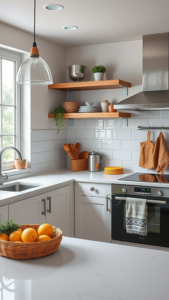Effective Home Cleaning Tips for Your Kitchen
Your kitchen is often the heart of your home, but it can also be one of the messiest places. With the right cleaning tips and strategies, you can keep it sparkling and inviting. Here are some effective home cleaning tips for your kitchen that will make the task easier and more enjoyable.
Prepare Your Cleaning Supplies
Before diving into cleaning, gather all the supplies you need. This saves time and ensures you’re ready for any mess. Essential items include:
- Multi-surface cleaner
- Microfiber cloths
- Sponges
- Baking soda
- White vinegar
- Dish soap
- Rubber gloves
Having everything at hand allows you to clean efficiently without interruptions.
Start with Decluttering
Begin by taking a few minutes to declutter your kitchen. Remove items that don’t belong, return appliances to their rightful spots, and sort through any papers or utensils on the counter. This visual tidiness can give you a sense of accomplishment and make the cleaning process more manageable.
Clean the Surfaces
Next, focus on cleaning countertops, tables, and other surfaces. Here’s how:
- Spray a multi-surface cleaner on the areas and let it sit for a minute.
- Wipe down with a microfiber cloth, using circular motions for stubborn spots.
- Don’t forget to clean the backsplash and corners where crumbs tend to hide.
Using natural cleaners, like a vinegar solution, can effectively remove grease and grime.
Focus on the Sink
Your kitchen sink can be a hotspot for bacteria. Here’s a quick cleaning approach:
- Clear the sink of dishes and debris.
- Sprinkle baking soda along the sink basin and scrub with a damp sponge.
- Rinse thoroughly with hot water.
- For a sparkling shine, wipe down with a vinegar-soaked cloth.
This routine not only cleans but also deodorizes the sink area.
Don’t Forget the Appliances
Cleaning your kitchen appliances can enhance their efficiency and lifespan. Here are quick tips:
- Refrigerator: Remove expired items and wipe down the shelves with a baking soda solution.
- Microwave: Place a bowl of water with lemon juice inside, heat for a few minutes, and then wipe clean.
- Oven: Use baking soda and water to make a paste, apply it to the dirty areas, and let it sit overnight before scrubbing.
Floor Care
Kitchens see a lot of foot traffic and spills, making floor cleaning essential. Here’s a method to refresh your floors:
- First, sweep or vacuum to remove loose dirt and debris.
- Next, mop with warm soapy water. You can use a mixture of vinegar and water for added disinfecting.
- If you have tiles, pay extra attention to grout lines using a brush for deeper cleaning.
Organize as You Go
Cleaning doesn’t just involve scrubbing surfaces. It’s also an excellent opportunity to organize. While you clean, think about reorganizing your kitchen items:
- Group similar items together.
- Ensure your most used items are within easy reach.
- Consider investing in drawer dividers or shelf organizers to maximize space.
Organization leads to less clutter and makes future cleaning easier.
Set a Cleaning Routine
The key to maintaining a clean kitchen is consistency. Setting a regular cleaning schedule can help. You might choose to:
- Wipe down surfaces daily.
- Deep clean appliances weekly.
- Organize and declutter monthly.
Your kitchen will remain a pleasant space where you can cook, dine, and enjoy family time when you create a routine.
By incorporating these effective home cleaning tips for your kitchen, you’ll create a cleaner and more enjoyable space. Happy cleaning!
Eco-Friendly Cleaning Products for a Safer Kitchen Environment
Creating a safer kitchen environment doesn’t just mean keeping it clean; it also involves being mindful of the products you use for cleaning. Traditional cleaning agents often contain harsh chemicals that can impact your health and the environment. By shifting to eco-friendly cleaning products, you can ensure your kitchen is a safe space while protecting our planet.
Why choose eco-friendly options? First and foremost, they reduce your exposure to harmful toxins that can linger in your food preparation area. Many conventional cleaners can leave behind residues that may contaminate your cooking surfaces and utensils. Eco-friendly products, on the other hand, utilize natural ingredients that offer effective cleaning power without harmful side effects.
There are various types of eco-friendly cleaning products available that cater specifically to kitchen cleaning needs. These often include:
- All-Purpose Cleaners: These can be used on various surfaces, including countertops and appliances. Look for products made from plant-based ingredients to ensure safety for both you and the environment.
- Dishwashing Liquids: Traditional dish soaps may contain phosphates and surfactants that harm aquatic life. Eco-friendly dish soap uses biodegradable ingredients that clean effectively without leaving harmful residues.
- Oven Cleaners: Opt for non-toxic oven cleaners that dissolve grease and grime without emitting harmful fumes. Many of these products use natural baking soda or vinegar as active ingredients.
- Floor Cleaners: For mopping your kitchen floor, consider plant-based floor cleaners that won’t leave behind toxic residues, making it safe for kids and pets.
- Glass Cleaners: Choose vinegar-based or other natural glass cleaners for streak-free shine that doesn’t harm the environment.
When selecting eco-friendly cleaning products, read the labels carefully. Look for certifications like the Green Seal or EcoLogo, which indicate that the product meets strict environmental and health criteria. Additionally, be aware of fragrance components; many artificial fragrances can cause allergic reactions or respiratory issues. Instead, opt for products that use essential oils for a pleasant scent.
It’s also beneficial to craft some DIY cleaning solutions using simple, everyday items you may already have at home. Here are a few easy recipes:
- All-Purpose Cleaner: Combine equal parts water and distilled vinegar in a spray bottle. This mixture can tackle most surfaces. Add a few drops of essential oils for a fresh scent.
- Grease Remover: Mix baking soda and water to form a paste. Apply it to greasy areas and scrub with a brush for effective removal.
- Glass Cleaner: In a spray bottle, mix 2 cups of water with ½ cup of vinegar and ¼ cup of rubbing alcohol. This formula is great for leaving your glass surfaces sparkling clean.
Implementing eco-friendly cleaning products is just one part of creating a safer kitchen. You can enhance your efforts by following these additional tips:
- Ventilate the Kitchen: Always ensure proper ventilation when cleaning. Open windows or use exhaust fans to avoid inhaling any fumes.
- Store Products Safely: Keep all cleaning supplies out of reach of children and pets, even if they are labeled as eco-friendly.
- Minimize Waste: Opt for refillable cleaning products or purchase in bulk to reduce packaging waste.
- Choose Reusable Supplies: Instead of disposable cloths or sponges, use washable rags and mop heads to cut down on waste.
Eco-friendly cleaning products into your kitchen routine not only promotes better health for you and your family but also reduces your carbon footprint. By choosing natural, safe alternatives, you can contribute to a cleaner environment while enjoying the pleasures of cooking and gathering in your kitchen.
Remember, a clean kitchen is a happy kitchen. By making mindful choices about the cleaning products you use, you nurture both your home and the planet, creating a sustainable future for generations to come.
Conclusion
A clean and organized kitchen not only enhances your home’s appeal but also plays a critical role in maintaining the health and safety of your family. By implementing effective home cleaning tips, you can ensure that your kitchen remains a welcoming space, free from germs and clutter. Regular practices like wiping down surfaces, disinfecting high-touch areas, and keeping the floors clean create a happier cooking environment and foster good habits for all members of the household.
Moreover, by choosing eco-friendly cleaning products, you’re making a positive impact on the planet while protecting your family’s well-being. These sustainable options are gentle on your surfaces yet powerful against dirt and germs. They reduce harmful chemicals in your home, ensuring that your kitchen is not only clean but safe for cooking and eating.
Balancing cleanliness with sustainability leads to a kitchen that mirrors your values while serving as a hub for family gatherings and meals. Embrace these practices, and you’ll not only achieve a spotless kitchen but also contribute to a more sustainable future. Remember, a clean kitchen is a happier kitchen, so put these tips into action and enjoy the benefits that come from a tidy, eco-conscious space. Make your kitchen not just a place for cooking, but an environment that reflects care for both your family and the Earth.




